

Presented by: Joris Jonkers Both & Patrick Spaans Supervisor: Alexandru Geana Analyzing embedded software technologies on RISC-V64 using Ghidra driving your security forward 1
Introduction RISC-V64 - Like ARM but open source - One base image - Extendable with extensions (e.g. M for multiplications) - 2
Introduction RISC-V64 - Like ARM but open source - One base image - Extendable with extensions (e.g. M for multiplications) - Security of embedded systems 3
Introduction RISC-V64 - Like ARM but open source - One base image - Extendable with extensions (e.g. M for multiplications) - Security of embedded systems Ghidra SRE Framework 4
Introduction RISC-V64 - Like ARM but open source - One base image - Extendable with extensions (e.g. M for multiplications) - Security of embedded systems Ghidra SRE Framework Kendryte K210 SoC - System on a Chip - Maix-bit - AI capable IoT device 5
Related Work Ghidra only recently open source Analyzing security using reverse engineering is not a new concept - Udupa et al. in 2005 - Zaddach and Costin in 2013 6
RISC-V64 Supported extensions { I → base integer instruction set M → standard integer multiplication & division extension G A → standard atomic instruction extension F → single-precision floating-point extension D → standard double-precision floating-point extension C → standard extension for compressed instructions Q → standard extension for quad-precision floating-point 7
RISC-V64 Supported extensions { I → base integer instruction set M → standard integer multiplication & division extension G A → standard atomic instruction extension F → single-precision floating-point extension D → standard double-precision floating-point extension C → standard extension for compressed instructions Q → standard extension for quad-precision floating-point So, Risc-V64GC == Risc-V64IMAFDC... 8
Research Question In what ways can a disassembly and decompile tool be used to analyze and enhance the working of embedded technologies? 9
Research Subquestions - What are the possibilities of implementing a Ghidra plugin for RISC-V? - What are the possibilities of using reverse-engineering to enable hidden features on the Kendryte K210? 10
Methodology Creating a Ghidra Plugin for RISC-V64GC Reverse engineering the Kendryte K210 bootrom Research into writing to the Kendryte K210 OTP in order to implement secure boot 11
Creating a Ghidra Plugin for RISC-V64GC - Add support for architectures - Specifies register layouts and hardware specs - Must contain all instructions specifications to allow successful decompilation 12 confidential
Creating a Ghidra Plugin Plugin structure .ldefs file (language definition) 13
Creating a Ghidra Plugin Plugin structure .ldefs file (language definition) .sla file Example: (Instruction definitions) 14
Creating a Ghidra Plugin Plugin structure .ldefs file (language definition) .sla file (Instruction definitions) .pspec file (Processor specification) 15
Creating a Ghidra Plugin Plugin structure .ldefs file (language definition) .sla file (Instruction definitions) .pspec file (Processor specification) .cspec file (Compiler specification) 16 ...
Creating a Ghidra Plugin Plugin structure .ldefs file (language definition) .sla file (Instruction definitions) .pspec file (Processor specification) .cspec file (Compiler specification) 17
Reverse engineering the Kendryte K210 bootrom Using the plugin … 18
Reverse engineering the Kendryte K210 bootrom Using the plugin … Can be: “f3 01 e7 00” or “f3 01” Neither are in the documentation … 19
Reverse engineering the Kendryte K210 bootrom Using an alternative reverse engineering tool An alternative to Ghidra could be used to find out more about these functions. 20
Reverse engineering the Kendryte K210 bootrom Using an alternative reverse engineering tool An alternative to Ghidra could be used to find out more about these functions. Ghidra Radare2 21
Reverse engineering the Kendryte K210 bootrom Using the complete bootrom 22
Reverse engineering the Kendryte K210 bootrom Using the complete bootrom There are still some unrecognized instructions 23
Reverse engineering the Kendryte K210 bootrom Debugging Using J-Link and OpenOCD (on-chip-debugger) 24
Reverse engineering the Kendryte K210 bootrom Debugging It turns out that all instructions left were no actual instructions 25
Research into writing to the Kendryte K210 OTP Implementing secure boot 26
Research into writing to the Kendryte K210 OTP Implementing secure boot 27
Research into writing to the Kendryte K210 OTP Implementing secure boot 28
Research into writing to the Kendryte K210 OTP Implementing secure boot 29
Research into writing to the Kendryte K210 OTP Implementing secure boot 30
Research into writing to the Kendryte K210 OTP Implementing secure boot 31
Research into writing to the Kendryte K210 OTP Trying to write to the OTP We used the Ghidra plugin to find the OTP write function 32
Research into writing to the Kendryte K210 OTP Trying to write to the OTP We used the Ghidra plugin to find the OTP write function While being the correct function, it is yet unable to write 33
Research into writing to the Kendryte K210 OTP What is this return value? In the function, the following is specified: 34
Research into writing to the Kendryte K210 OTP What is this return value? In the function, the following is specified: So what is this _DAT_50420060? 35
The Ghidra Plugin works, and is Conclusion able to completely reverse engineer the Kendryte K210 Bootrom However, it is not possible to enable any features that require writing to the OTP if the write disabling bit has been set. 36
Test the write function on a Future Work Kendryte K210 chip with an unwritten OTP Use the Ghidra Plugin as a means to analyze the security of embedded SoC’s Enable other features of the Kendryte K210 using reverse engineering Create a plugin for other RISC-V types or extensions 37
Recommend
More recommend